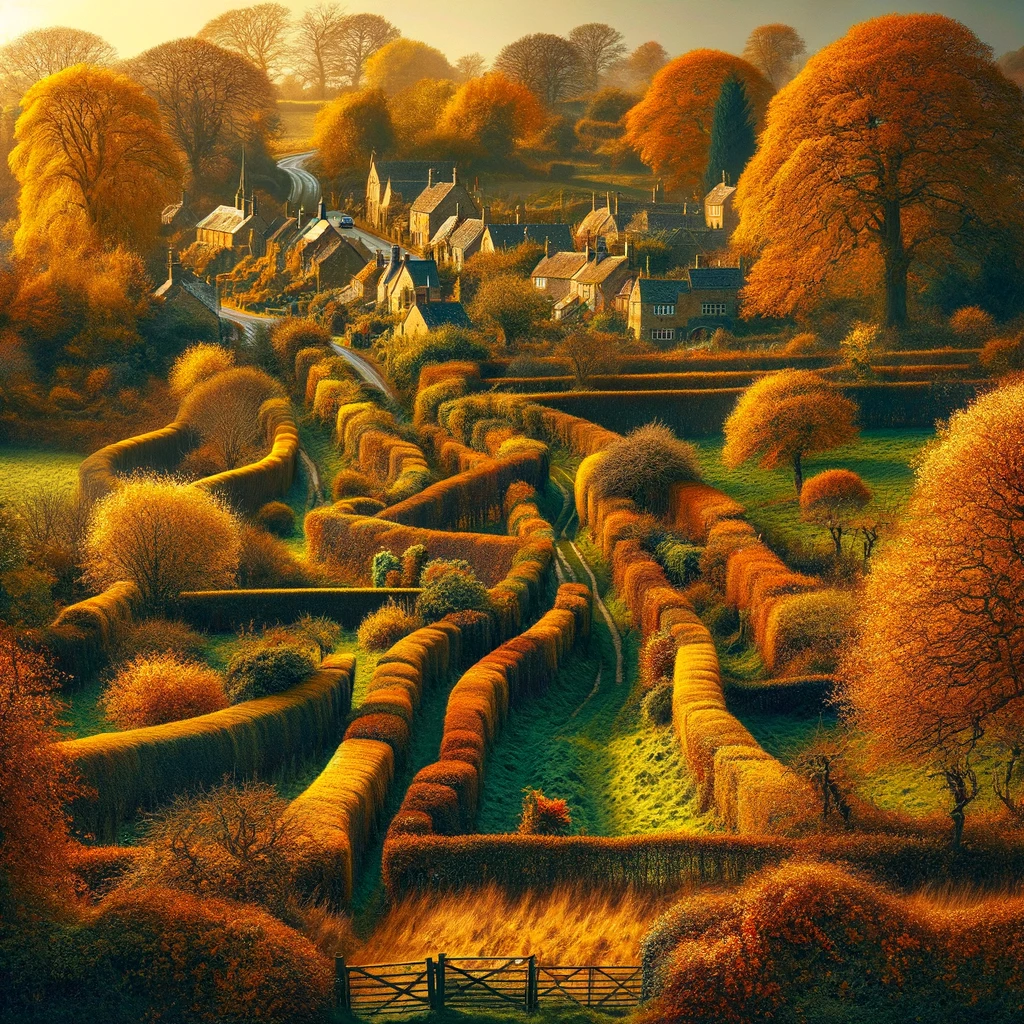A new map has been made that shows all the hedgerows in England. If you lined up all the hedgerows end to end, they would go around the Earth almost ten times! This map is really detailed and will help scientists who study nature. Hedgerows are important because they look nice and they help animals and plants. They also help to store carbon. The map shows that there are 390,000 kilometers of hedgerows in England, with the most in the South West.
The person in charge of the project, Dr. Richard Broughton, says that England probably has more hedgerows than any other country. This is a good thing because the government wants to make more hedgerows. The map will help them see where there are gaps in the hedgerows that need to be filled. Hedgerows have been around in England since a long time ago and they were used to keep cows in. They are home to lots of different plants and animals.
It’s not good news though, because lots of hedgerows were lost between the 1940s and 1990s. This happened because of farming and building. Even though it’s not happening as much now, hedgerows are still being damaged or taken away. The new map is really helpful because it gives more information than before. It shows that there are 390,000 kilometers of hedgerows in England, with some being 1 meter tall and others being 6 meters tall.
The map also shows that some parts of England have more hedgerows than others. The South West has the most, while the northeast has the least. At the county level, Somerset, Derbyshire, and Cornwall have the most hedgerows, while Surrey, Hampshire, and Berkshire have the fewest. The government has said that they want to make or fix 48,000 kilometers of hedgerows by 2037 and 72,000 kilometers by 2050. This is part of a plan to make the environment better.
In conclusion, this new map is really useful because it tells us a lot about England’s hedgerows. It shows that they are important and need to be protected and made more.
Original news source: England’s hedges would go around Earth ten times (BBC)
🎧 Listen:
Slow
Normal
Fast
📖 Vocabulary:
| 1 | detailed | Having lots of specific facts or pieces of information |
| 2 | carbon | A chemical element that all living things are made of, and it’s also in the air and many fuels |
| 3 | scientists | People who study the natural world and try to learn new things about it |
| 4 | gaps | Empty spaces or missing parts in something |
| 5 | ancient | Very old or from a long time ago |
| 6 | agriculture | The practice of farming, including growing crops and raising animals |
| 7 | damaged | Hurt or made less effective |
| 8 | information | Facts or details that tell you something about a situation, person, or thing |
| 9 | environment | The natural world around us, including the air, water, and land |
| 10 | protected | Kept safe from harm or danger |
| 11 | useful | Being able to provide help or benefits |
| 12 | government | The group of people who are responsible for making the laws and managing the country |
| 13 | project | A planned piece of work that is designed to find information, produce something new, or achieve a specific goal |
| 14 | initiative | A new plan or process to achieve something or solve a problem |
| 15 | hedgerows | Long rows of bushes and small trees planted near each other, often used to mark the boundary of an area |
Group or Classroom Activities
Warm-up Activities:
– News Summary
Instructions: Divide the class into pairs or small groups. Give each group a few minutes to read the article. Then, ask them to summarize the main points of the article in their own words. Afterward, have each group share their summary with the rest of the class.
– Opinion Poll
Instructions: Write the following statement on the board: “Hedgerows are important for the environment.” Divide the class into two groups and assign one group to agree with the statement and the other group to disagree. Give the groups a few minutes to discuss their opinions and come up with reasons to support their stance. Then, conduct a class poll by asking each student to vote on whether they agree or disagree with the statement. Finally, have a class discussion where students can share their opinions and reasons.
– Vocabulary Pictionary
Instructions: Write a list of vocabulary words from the article on the board (e.g., hedgerows, carbon, project, government, environment). Divide the class into pairs or small groups. Give each group a whiteboard or large piece of paper. One student from each group will choose a word from the list and draw a picture to represent that word. The rest of the group must guess the word based on the drawing. The group that guesses correctly earns a point. Continue until all the words have been guessed or time runs out. The group with the most points wins.
– Pros and Cons
Instructions: Divide the class into pairs or small groups. Ask each group to discuss the pros and cons of having hedgerows. Give them a few minutes to brainstorm and write down their ideas. Then, have each group share their points with the rest of the class. Encourage a class discussion where students can debate the advantages and disadvantages of hedgerows.
– Future Predictions
Instructions: Ask students to imagine what England’s hedgerows will be like in the future. Will there be more or fewer hedgerows? Will they be better protected? Will they have a different purpose? In pairs or small groups, have students discuss and make predictions about the future of hedgerows in England. Afterward, ask a few groups to share their predictions with the class. Encourage students to support their predictions with reasons and evidence from the article.
🤔 Comprehension Questions:
1. What does the new map show about the hedgerows in England?
2. Why are hedgerows important for animals and plants?
3. Who is in charge of the project to map the hedgerows in England?
4. Why is it good that England has a lot of hedgerows?
5. What happened to many hedgerows between the 1940s and 1990s?
6. How does the new map help the government?
7. Which parts of England have the most hedgerows? Which parts have the least?
8. What is the government’s plan for hedgerows in the future?
Go to answers ⇩
🎧✍️ Listen and Fill in the Gaps:
A new map has been made that shows all the (1)______ in England. If you (2)______ up all the hedgerows end to end, they would go around the Earth almost ten times! This map is really detailed and will help scientists who study nature. Hedgerows are important because they look nice and they help animals and plants. They also help to store carbon. The map shows that there are 390,000 kilometers of hedgerows in England, with the most in the South West.
The (3)______ in (4)______ of the project, Dr. Richard Broughton, says that (5)______ probably has more hedgerows than any other country. This is a good (6)______ because the government wants to make more hedgerows. The map will help them see where there are gaps in the hedgerows that need to be filled. Hedgerows have been around in England since a long time ago and they were used to keep cows in. They are home to lots of different (7)______ and (8)______.
It’s not good news though, because lots of hedgerows were lost between the 1940s and 1990s. This happened because of (9)______ and (10)______. Even though it’s not happening as much now, hedgerows are still being (11)______ or (12)______ away. The new map is really helpful because it gives more information than before. It shows that there are 390,000 kilometers of hedgerows in England, with some being 1 meter tall and others being 6 meters tall.
The map also shows that some parts of England have more hedgerows than others. The South West has the most, while the northeast has the least. At the county level, Somerset, Derbyshire, and (13)______ have the most hedgerows, while Surrey, Hampshire, and Berkshire have the fewest. The government has said that they want to make or fix 48,000 kilometers of hedgerows by 2037 and 72,000 kilometers by 2050. This is part of a plan to make the environment better.
In (14)______, this new map is really useful because it (15)______ us a lot about England’s hedgerows. It (16)______ that they are important and need to be protected and made more.
Go to answers ⇩
💬 Discussion Questions:
Students can ask a partner these questions, or discuss them as a group.
1. What is a hedgerow and why are they important?
2. How do hedgerows help animals and plants?
3. Do you think it’s important to protect hedgerows? Why or why not?
4. How would you feel if you found out that many hedgerows were lost between the 1940s and 1990s?
5. Have you ever seen a hedgerow? Where and what did it look like?
6. Do you like the idea of the government making more hedgerows? Why or why not?
7. How do you think the new map will help the government fill gaps in the hedgerows?
8. Why do you think the South West has the most hedgerows in England?
9. Do you think it’s fair that some parts of England have more hedgerows than others? Why or why not?
10. How would you feel if you lived in a county with very few hedgerows?
11. What do you think will happen to the environment if more hedgerows are made and fixed?
12. Have you ever seen any animals or plants in a hedgerow? What were they?
13. How do you think hedgerows can help store carbon?
14. Do you think other countries should also make more hedgerows? Why or why not?
15. Why do you think the government has set goals to make and fix a certain number of kilometers of hedgerows by specific years?
Individual Activities
📖💭 Vocabulary Meanings:
Match each word to its meaning.
Words:
1. detailed
2. carbon
3. scientists
4. gaps
5. ancient
6. agriculture
7. damaged
8. information
9. environment
10. protected
11. useful
12. government
13. project
14. initiative
15. hedgerows
Meanings:
(A) A planned piece of work that is designed to find information, produce something new, or achieve a specific goal
(B) Hurt or made less effective
(C) A chemical element that all living things are made of, and it’s also in the air and many fuels
(D) Very old or from a long time ago
(E) A new plan or process to achieve something or solve a problem
(F) The practice of farming, including growing crops and raising animals
(G) Kept safe from harm or danger
(H) The natural world around us, including the air, water, and land
(I) Being able to provide help or benefits
(J) Facts or details that tell you something about a situation, person, or thing
(K) Empty spaces or missing parts in something
(L) People who study the natural world and try to learn new things about it
(M) The group of people who are responsible for making the laws and managing the country
(N) Having lots of specific facts or pieces of information
(O) Long rows of bushes and small trees planted near each other, often used to mark the boundary of an area
Go to answers ⇩
🔡 Multiple Choice Questions:
1. What is the purpose of the new map of hedgerows in England?
(a) To show the most popular tourist destinations
(b) To help scientists study nature
(c) To track the migration patterns of birds
(d) To identify the locations of ancient ruins
2. How many kilometers of hedgerows are there in England?
(a) 100,000
(b) 500,000
(c) 1,000,000
(d) 390,000
3. Which region of England has the most hedgerows?
(a) South West
(b) North East
(c) Midlands
(d) South East
4. What is the main reason why hedgerows were lost between the 1940s and 1990s?
(a) Natural disasters
(b) Farming and building
(c) Animal migration
(d) Climate change
5. What is the height range of the hedgerows mentioned in the article?
(a) 1 meter to 6 meters
(b) 10 meters to 20 meters
(c) 0.5 meters to 1 meter
(d) 3 meters to 5 meters
6. Which three counties have the most hedgerows?
(a) Surrey, Hampshire, Berkshire
(b) Yorkshire, Lancashire, Cumbria
(c) Somerset, Derbyshire, Cornwall
(d) Norfolk, Suffolk, Essex
7. What is the government’s plan regarding hedgerows?
(a) To remove all hedgerows by 2037
(b) To double the number of hedgerows by 2037
(c) To create a national park dedicated to hedgerows
(d) To make or fix 48,000 kilometers by 2037 and 72,000 kilometers by 2050
8. Why are hedgerows important?
(a) They provide shade for farmers and their livestock
(b) They prevent erosion and flooding
(c) They help animals and plants, store carbon, and look nice
(d) They are a popular tourist attraction in England
Go to answers ⇩
🕵️ True or False Questions:
1. The map will help scientists who study nature.
2. The government wants to create more hedgerows and the map will help identify gaps that need to be filled.
3. A new map has been created that shows all the hedgerows in England.
4. If you lined up all the hedgerows in England, they would go around the Earth almost ten times.
5. The map discloses that there are 390,000 kilometers of hedgerows in England, with the majority in the South East.
6. England possibly has fewer hedgerows than any other country.
7. Hedgerows are significant because they enhance the landscape and support animals and plants.
8. Between the 1940s and 1990s, numerous hedgerows were preserved due to farming and building, but the map offers more data to safeguard and develop new hedgerows.
Go to answers ⇩
📝 Write a Summary:
Write a summary of this news article in two sentences.
Check your writing now with the best free AI for English writing!
Writing Questions:
Answer the following questions. Write as much as you can for each answer.
Check your answers with our free English writing assistant!
1. What is the purpose of the new map that shows all the hedgerows in England?
2. Why are hedgerows important for animals and plants?
3. According to Dr. Richard Broughton, why is it a good thing that England has a lot of hedgerows?
4. What caused the loss of many hedgerows between the 1940s and 1990s?
5. Which regions in England have the most and least amount of hedgerows?
✅ Answers
🤔✅ Comprehension Question Answers:
1. The new map shows that there are 390,000 kilometers of hedgerows in England.
2. Hedgerows are important for animals and plants because they provide habitats for them to live in and food for them to eat. They also help to store carbon and prevent soil erosion.
3. Dr. Richard Broughton is in charge of the project to map the hedgerows in England.
4. It is good that England has a lot of hedgerows because they are important for the environment and biodiversity. They also help to make the countryside look beautiful.
5. Many hedgerows were lost between the 1940s and 1990s due to farming and building activities.
6. The new map helps the government by showing them where there are gaps in the hedgerows that need to be filled. It also provides more detailed information about the hedgerows in England.
7. The South West of England has the most hedgerows, while the northeast has the least.
8. The government’s plan for hedgerows in the future is to make or fix 48,000 kilometers of hedgerows by 2037 and 72,000 kilometers by 2050. This is part of a plan to improve the environment.
Go back to questions ⇧
🎧✍️✅ Listen and Fill in the Gaps Answers:
(1) hedgerows
(2) lined
(3) person
(4) charge
(5) England
(6) thing
(7) plants
(8) animals
(9) farming
(10) building
(11) damaged
(12) taken
(13) Cornwall
(14) conclusion
(15) tells
(16) shows
Go back to questions ⇧
📖💭✅ Vocabulary Meanings Answers:
1. detailed
Answer: (N) Having lots of specific facts or pieces of information
2. carbon
Answer: (C) A chemical element that all living things are made of, and it’s also in the air and many fuels
3. scientists
Answer: (L) People who study the natural world and try to learn new things about it
4. gaps
Answer: (K) Empty spaces or missing parts in something
5. ancient
Answer: (D) Very old or from a long time ago
6. agriculture
Answer: (F) The practice of farming, including growing crops and raising animals
7. damaged
Answer: (B) Hurt or made less effective
8. information
Answer: (J) Facts or details that tell you something about a situation, person, or thing
9. environment
Answer: (H) The natural world around us, including the air, water, and land
10. protected
Answer: (G) Kept safe from harm or danger
11. useful
Answer: (I) Being able to provide help or benefits
12. government
Answer: (M) The group of people who are responsible for making the laws and managing the country
13. project
Answer: (A) A planned piece of work that is designed to find information, produce something new, or achieve a specific goal
14. initiative
Answer: (E) A new plan or process to achieve something or solve a problem
15. hedgerows
Answer: (O) Long rows of bushes and small trees planted near each other, often used to mark the boundary of an area
Go back to questions ⇧
🔡✅ Multiple Choice Answers:
1. What is the purpose of the new map of hedgerows in England?
Answer: (b) To help scientists study nature
2. How many kilometers of hedgerows are there in England?
Answer: (d) 390,000
3. Which region of England has the most hedgerows?
Answer: (a) South West
4. What is the main reason why hedgerows were lost between the 1940s and 1990s?
Answer: (b) Farming and building
5. What is the height range of the hedgerows mentioned in the article?
Answer: (a) 1 meter to 6 meters
6. Which three counties have the most hedgerows?
Answer: (c) Somerset, Derbyshire, Cornwall
7. What is the government’s plan regarding hedgerows?
Answer: (d) To make or fix 48,000 kilometers by 2037 and 72,000 kilometers by 2050
8. Why are hedgerows important?
Answer: (c) They help animals and plants, store carbon, and look nice
Go back to questions ⇧
🕵️✅ True or False Answers:
1. The map will help scientists who study nature. (Answer: True)
2. The government wants to create more hedgerows and the map will help identify gaps that need to be filled. (Answer: True)
3. A new map has been created that shows all the hedgerows in England. (Answer: True)
4. If you lined up all the hedgerows in England, they would go around the Earth almost ten times. (Answer: True)
5. The map discloses that there are 390,000 kilometers of hedgerows in England, with the majority in the South East. (Answer: False)
6. England possibly has fewer hedgerows than any other country. (Answer: False)
7. Hedgerows are significant because they enhance the landscape and support animals and plants. (Answer: False)
8. Between the 1940s and 1990s, numerous hedgerows were preserved due to farming and building, but the map offers more data to safeguard and develop new hedgerows. (Answer: False)
Go back to questions ⇧













